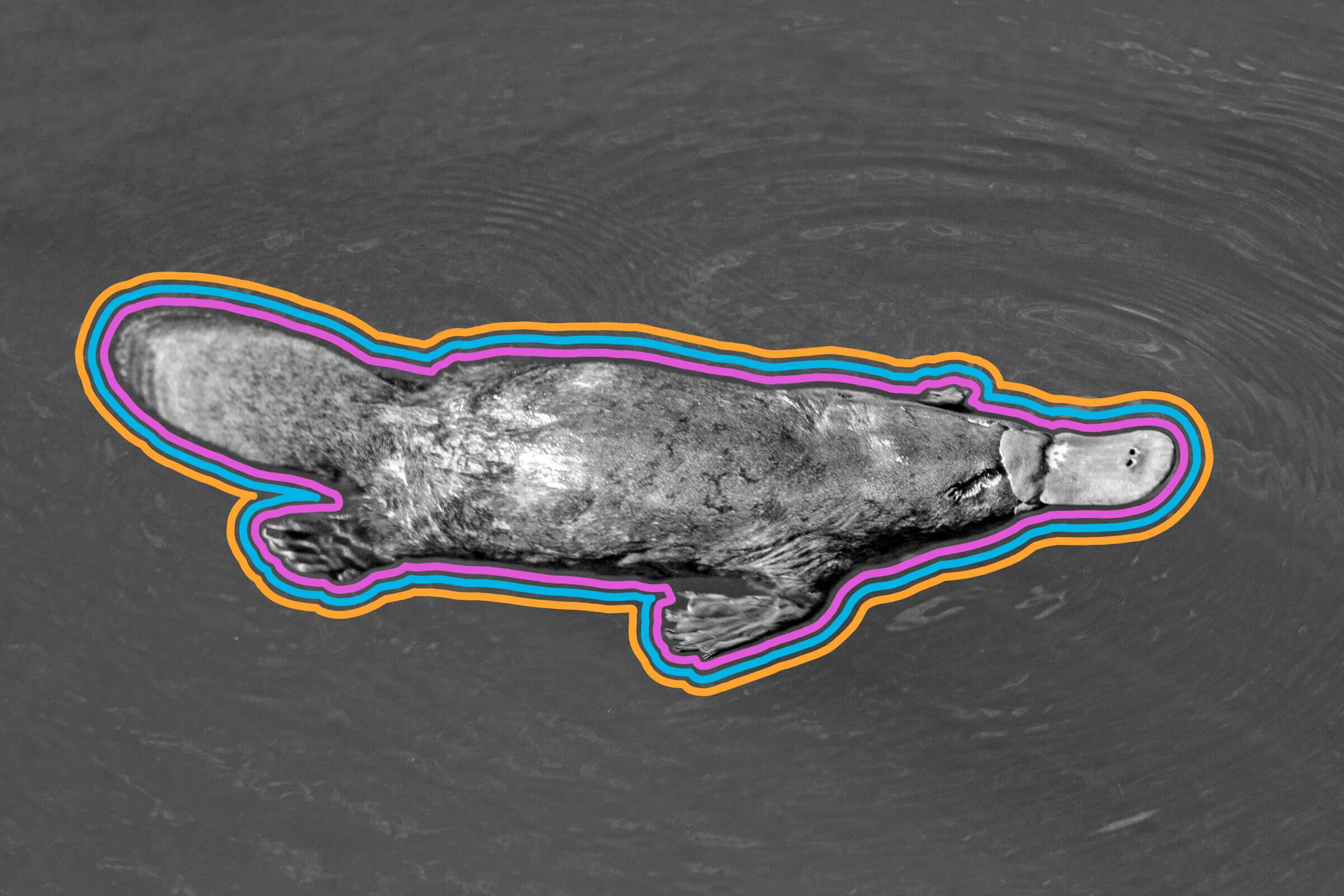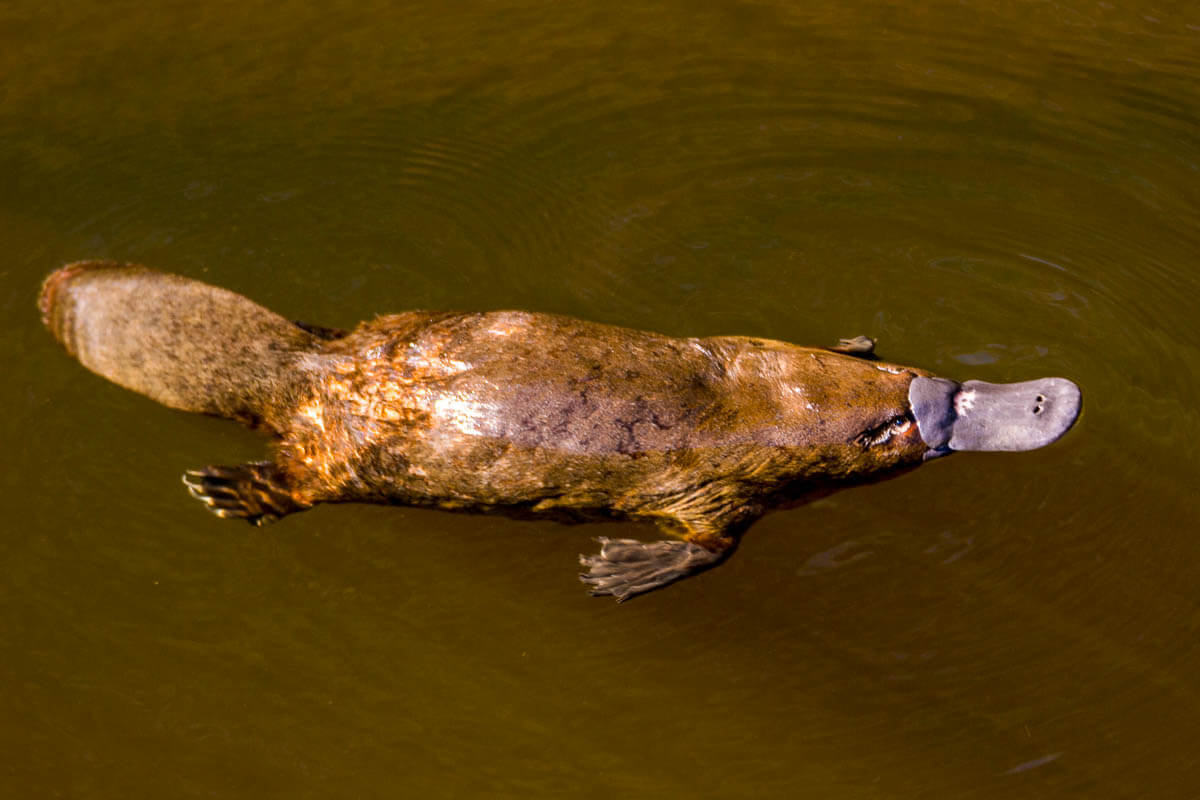

If you know one thing about the platypus, it’s probably that it’s one of the planet’s weirdest species. These Australian creatures are furry mammals, but they reproduce by laying eggs — and if that wasn’t odd enough, they’re also amphibious. Their strange circumstances are matched by their goofy looks, which include duck-like bills, beaver-like tails, and dense fur.
Platypuses (yes, that’s a correct plural, although “platypi” is fine too) have a lot of wild things going on, and these seven facts show just how fascinating they can be. They’re bottom-feeders, but how do they hunt without being able to see, hear, or smell underwater? How do they chew with no teeth? Why should you, at all costs, avoid male platypuses’ feet during mating season? Read on to more fully grasp just how weird and wonderful these animals are.
Early British Naturalists Didn’t Totally Believe in Them

Imagine seeing a platypus for the first time with absolutely no context. When a group of British naturalists first laid eyes on a (lifeless) platypus specimen shipped from Australia in the late 18th century, they thought it could be a kind of taxidermy prank.
"It naturally excites the idea of some deceptive preparation by artificial means," wrote English zoologist George Shaw in 1799, although he concluded, after “the most minute and rigid examination,” that it was the real deal. He also noted that the creature appeared to be a combination of a duck and perhaps a small otter or a beaver. And one of the early British colonizers of Australia thought it was an amphibious species of mole.
Shaw dubbed the creature the Platypus anatinus, or “flat-foot duck.” A few years later, a German naturalist named it Ornithorhynchus paradoxus, or “paradoxical bird-snout.” It turns out there was already a genus of beetle called Platypus, so science reconciled the two names to Ornithorhynchus anatinus, which is still its scientific name today.
“Platypus” stuck as the common name in the Western world. Aboriginal names for the animal have been around for longer, and include “boondaburra,” “mallingong,” and “tambreet,” depending on the region.
Their Fur Is Waterproof

Like many animals, platypuses have two layers of fur for insulation — but unlike in most species, the top layer is waterproof. Their undercoat is incredibly dense, which keeps the platypus warm in cold water. It’s covered by a coat of long, coarse hairs that trap air and keep the inner layer from getting wet, even after hours submerged in the water. The insulation effect, according to the Australian Platypus Conservancy, is comparable to a neoprene wetsuit about three millimeters thick.
They’re Equipped With Built-In Earplugs, Nose Plugs, and Goggles

Platypuses spend a lot of time hunting underwater and are able to swim far more gracefully than they can walk. Their front claws have retractable webbing for optimal paddling, and they use their hind feet and beaver-like tail for quick and easy turning.
Because they’re also land mammals, though, their bodies are built to protect their less-waterproof features while submerged, with specialized skin flaps that cover their ears and eyes, and nostrils that are able to close completely and create a waterproof seal. They’re bottom-feeders, and this allows them to spend plenty of time in muddy lakebeds gathering insects, worms, and small shellfish. Fortunately, they don’t need to see, smell, or hear to track that prey down, because…
Platypus Bills Have a Sixth Sense

Platypuses gather food without sight, smell, or hearing underwater, making even alternate navigation systems like sound-based echolocation impractical. Luckily, they have a sensory organ that’s rare in the animal kingdom: They sense electric fields with their bills.
Three different receptor cells in their bills detect motion, changes in pressure, and electric signals produced by muscle contractions in their prey. They move their heads from side to side to gather this information, figure out direction and distance, and ultimately go for the catch.
This is called electroreception, and only a handful of species have the capability. Besides monotremes, i.e. egg-laying mammals — a category that includes only the platypus and anteater-like echidna, also native to Australia — a few species of fish have it, too, and, to a lesser extent, bumblebees.
They Chew Their Food Using Rocks They Pick Up While Hunting

When the platypus reaches its dinner and scoops it up from the bottom of a lake or river, it makes sure to take a little gravel with it — after all, platypuses have no teeth, and need to masticate their food somehow. The hunter tucks everything into pouches in its cheeks and comes back up on land to dine, using the rocks to mash it all up in its mouth. After swallowing the soft parts of its prey, it spits out any leftover exoskeletons, along with the gravel.
While this might seem similar to what some birds, like chickens, do by picking up grit, it’s not quite as sophisticated. Birds use rocks to digest food in a second part of the stomach called the gizzard; platypuses literally just crunch them around in their mouths. In fact…
Platypuses Have No Stomachs

When platypuses eat, their food goes directly from the gullet to their intestines, with no stomach to break down food further. It’s not unheard of in mammals — they share this trait with their fellow monotremes — but most stomachless animals are species of fish.
The intestines have their own enzymes that break down food, and many stomachless species eat diets rich in calcium carbonate from sources like coral and shellfish. One theory is that with such an acid-neutralizing diet (imagine if you ate large quantities of Tums for every meal), acid-rich stomachs essentially became worthless wastes of energy somewhere along the evolutionary line.
Male Platypuses Store Potent, Painful Venom in Their Heels

Platypuses are pretty cute, in a weird way — but don’t let that deceive you. While they’re not on par with other Australian horrors like the box jellyfish, they have the dubious distinction of being one of the few venomous mammals on Earth, along with slow lorises, vampire bats, and some animals from the order eulipotyphla, which includes moles, hedgehogs, and shrews.
However, unlike most venomous mammals, they have a unique ability to really ruin a human’s day. Platypuses attack by viciously and repeatedly jamming specialized hind leg spurs into their opponents. When inflicted on people, these attacks cause extreme pain, which has been described by researchers as “immediate, sustained, and devastating.” One attack can cause near-total immobility for weeks, with lingering effects like increased sensitivity to pain and decreased mobility for months. Even morphine won’t dull the pain; those unlucky enough to experience platypus venom require nerve blockers for relief, sometimes for days.
Fortunately, there have been no reported fatalities in humans. The venom is present only in males and only during mating season, and researchers are not 100% clear about what its purpose is; the usual assumption is that the males primarily use it on each other to eliminate competition. While the attacks can be brutal, they’re not fatal to other platypuses, and usually only result in temporary paralysis.
